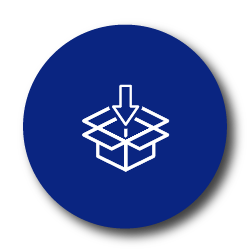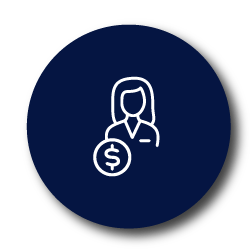
Like the Transformers, there's much more to ecommerce fulfillment costs than meets the eye. For businesses trying to understand the impact of fulfillment, how to manage it, and ways to forecast your budget, there's a lot of math and analysis ahead of you. However, mastering that complexity can make it much easier to understand where you need to go and spend wisely to get there.
So, let's look at all of the areas where you're spending in your warehouse and fulfillment centre, including many costs that can feel hidden. Fulfillment starts as soon as someone makes a purchase. An order is generated, moves through each order you ship, and includes costs associated with receiving new inventory and putting it on your shelves.
People, machines, and software all play a role, so we're going to need to look at each to understand what it costs you to keep customers happy.
One important note: We're looking chiefly at process-related fees. So, you'll also have the cost to actually ship each order to the end customer, with all its variables for speed, product size, and more. Consider turning to software to help automate that process to understand the standard and DIM weight calculations and select the carrier that gets your product there at the best time and price.

Software and setup
Software makes the modern warehouse run. You might use an ecommerce platform that helps with inventory counts and orders, or you could go for fulfillment modules within order management, warehouse management, and inventory management tools. Enterprise resource planning (ERP) software is also an option for larger ecommerce stores because of the warehouse and fulfillment modules.
Your software selection often has a fixed cost for setup and installation, as well as any custom development you need to ensure everything works properly. Some features, such as custom kitting and generating new SKUs, often need that additional support after you've bought the software.
After that up-front cost, you'll also want to track some ongoing charges. These include:
- Monthly subscriptions;
- Per-user fees;
- Ongoing training or onboarding;
- Fees for overages or based on how much you use the system;
- Vendor fees for customer service and support;
- Monthly internet access costs if you have a cloud system; and
- Devices needed to operate the software.
Your fulfillment process relies heavily on your software, so don't neglect it in terms of your total costs. If you're trying to understand cost-per-order, total the monthly software costs and divide this by your total number of orders to see how much each order costs you just in terms of software.

Infrastructure and location
To fill orders, you've got to have some space for everything else we'll talk about in this article. Your warehouse will require significant infrastructure to manage your operations. While you should consider the cost to build any physical space, install shelves, and take other fixed actions, we're going to set those aside when thinking about the fulfillment process itself. Some expenses will get covered in our monthly approach, so let's think about your warehousing.
First and foremost, there's a monthly cost to having space. Some of these will be fixed costs that you can plan for more readily:
- Rent or mortgage;
- State or federal taxes;
- Depreciation and interest;
- Insurance for your building, people, and materials;
- Lawn care, landscaping, and fixed management via contractors;
- Internet access and fixed utilities;
- Burglar alarms and other subscription services; and
- Guard services.
Variable costs for your space will include:
- Monthly utilities;
- Software to manage equipment, such as monthly subscriptions for recording and storing digital video surveillance;
- Loading dock maintenance;
- General building maintenance and upkeep, from replacing lights and fixing damage to expanding fencing or changing access points;
- Parking lot maintenance; and
- Pest control (might be a recurring monthly expense depending on location and products).
Materials and packaging
Your warehouse uses a broad set of equipment and materials to get orders moving. While it's easy to think just about boxes and tape, there are other considerations for the materials, handling, and packaging that you'll go through in a warehouse.
Remember that you'll not only need to cover what is used for specific orders but add some padding for errors and damage. You don't want a roof leak that ruins ten boxes to cause delays in your fulfillment.
Here are the big categories and items your warehouse will need to consider:
Handling and order management equipment
- Conveyors and belts, including maintenance;
- Pallet purchases or replacement costs;
- Lift trucks, carts, and dollies, either purchase prices or rental costs;
- Barcode scanners and handheld devices;
- Cases, cords, battery backups, and power stations;
- Additional fuel;
- Insurance costs on equipment;
- Equipment maintenance;
- Potential depreciation and interest costs;
- Printers for orders, labels, barcodes, and more; and
- Refills of ink, paper, and other consumables.
Order packaging and shipping
- Boxes for products and orders, potentially including box-cutting machinery;
- Tape for packaging products and boxes;
- Dunnage or filler materials, such as bubble wrap, paper, foam, etc.;
- Stickers or branding items;
- Waste or damaged filler and boxes;
- Trash and cleanup (time, garbage bags, city/county disposal costs); and
- Specialty inventory equipment from labels and reports to temperature monitors and insulation.
Labour costs
Fulfillment involves a significant amount of labour, and, in many cases, this will be a large chunk of your overall costs. Your warehouse labour is also complex, not only because of variable requirements due to product purchasing seasonality but because there is a mix of fixed, ongoing, and supplemental costs to consider.
While your specific mix may look different from the costs we list out, please note that labour is never just the salary or hourly wage you pay to your team.
Labour: direct costs
- Wages or salary for your standard warehouse team including pickers, packers, managers, cleaning, and support;
- Overtime costs;
- Bonus structure; and
- Wages for temporary employees.
Labour: employee benefits and fringe items
- Non-wage payments such as health insurance and pensions;
- Optional employee benefits such as life insurance;
- Vacation days and holiday pay;
- Sick leave, bereavement leave, and other paid days off;
- Uniforms and related cleaning; and
- Benefits or bonuses for temporary employees
Labour: fees
- FICA – the U.S. federal payroll tax;
- Workers' compensation payments and insurance; and
- Unemployment compensation.
Labour: ongoing elements
- Employee training for warehouse activities and software;
- Safety trainings required by OSHA and others;
- Educational allowances; and
- HR costs for certification and management of training.
Labour: advanced functionality costs
- Training for advanced functions or practices, such as managing returns or cross-docking;
- Additional hours for surges in demand of these practices, such spikes in returns common after year-end holiday sales;
- Order tracking and other help to support customer service agents;
- Inventory checking and handling; and
- Audits and reviews of returns goods and practices to ensure compliance and avoid product losses.
Don't neglect inbound shipments
One area that many fulfillment calculations tend to ignore is the cost of inbound shipment management. Your team will need to dedicate time and space to receiving goods from your suppliers or manufacturers. While the labour cost is already calculated, companies should remember that you have less labour to allocate to order fulfillment when an inbound shipment arrives.
If you're getting started with a warehouse, also note that inbound will need its own equipment. This not only makes it easier for everyone to have what they need but can limit potential issues with software and inventory counts.
Inbound shipments can also include returns and refunded items from customers. These require more time and judgment and, while also captured in our list above, can sometimes increase your costs by taking more time per order, needing review, and ongoing training.
Every new product that could potentially be returned and then sent to a new customer will need its own specific guidelines for what is acceptable and what needs to be trashed. That involves discussion and training for the product team, managers, workers, and audit teams.
Other potential inbound costs include customs and drayage fees if your goods are coming in from overseas.
Fee changes when outsourcing
One of the most common reasons growing ecommerce brands start to outsource fulfillment is that these costs scale with operations and can be challenging to control. When you need to move to a larger warehouse facility, you may incur a significant upfront cost for increased equipment, storage, shelving, and other space needs.
The move to a third-party logistics company, or 3PL, allows ecommerce brands to turn these many different fees into more predictable monthly costs. You pay a certain fee to receive inbound goods, store that inventory, a specific fee per order covering labour and materials, and other rates for special activities such as kitting or breaking down products to change their packaging. You're typically not responsible for wasted packaging materials and can recoup some inventory shrinkage costs.
You're trading some direct control for a cost that's easier to predict and manage. There are also other discounts you can benefit from, such as volume discounts from shippers based on the number of packages the 3PL sends out, not just your fulfillment volume.
Balance cost and service
Understanding the actual cost of ecommerce fulfillment is complicated. You'll need reliable tools and people to audit practices and analyse expenses across many functionalities. One of the best things your team can do for you is to turn this information into monthly averages and calculate a cost-per-order based on monthly volume.
Knowing your cost-per-order can help you determine if you need to pursue ways to cut costs or potentially change the pricing structure of goods to protect operations. This calculation can also help you weigh the potential benefits of outsourcing fulfillment and other operations based on 3PL vendor pricing.
Fulfillment is not only a core element of how you operate behind the scenes; it's also a part of your customer service. Quick, accurate orders make customers happy. Broken products, delayed shipping, and incorrect orders lead to frustration, refunds, and revenue loss.
Look for the option that best allows you to serve customers and afford to grow your business. Invest in methods, practices, and other elements that boost service and cost-control to become the best ecommerce store you can be.
Conclusion
Red Stag Fulfillment is a third-party fulfillment provider for ecommerce businesses with a new approach to the industry. Red Stag Fulfillment focuses on working with retailers that ship heavier-weight and bulkier parcels, or parcels that need some assembly before shipping.







